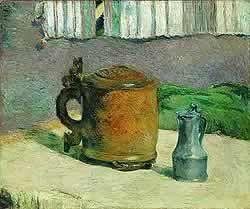
|
ORIGINS
Paul Gauguin and Vincent van Gogh, celebrated today for their profound impact on the history of modern painting, were both relative latecomers to art. By the time they met in the autumn of 1887, both men were well into their thirties (Gauguin 39, van Gogh 34), and each had several failed careers behind him.
Gauguin, who was born in France and spent part of his childhood in Peru, had worked as a merchant marine, stockbroker, tarpaulin salesman, and hanger of street posters before taking up painting in the summer of 1873. Although he initally approached art as a collector and Sunday painter, Gauguin gradually made it the focus of his life. Although married and supporting a family, Gauguin left his job in Paris to paint full-time beginning in 1883. During these early years, his work exhibited the detached brushstrokes and high-keyed color of Impressionism. Dutch-born van Gogh (or simply "Vincent," as he preferred to be known) had likewise attempted several professions, including art dealer, tutor, and preacher before committing himself to art in 1881. Van Gogh's early paintings portrayed peasants and rural themes, rendered in the dark, earth-toned palette favored by realist painters of France, Belgium, and his native Holland.

This early still life by Gauguin, characterized by the broken color and light palette of Impressionism, is thought to illustrate a fable by the 18th-century French writer Jean de La Fontaine, in which an iron jug convinces a reluctant clay jug to embark on a journey. The story stresses the virtue of caution, for during the trip, the clay jug breaks. The ill-matched pair of vessels may also have served as symbols for Gauguin and his wife, implying their incompatability and the dim prospects for the future of their marriage.
Van Gogh and Gauguin: The Studio of the South has been organized by The Art Institute of Chicago and the Van Gogh Museum, Amsterdam. This exhibition is supported by an indemnity from the Federal Council on the Arts and the Humanities.
Van Gogh and Gauguin: The Studio of the South is part of the "Ameritech Exhibition Series" made possible through a grant from the Ameritech Foundation.
|








